|
|
|
|
Isolation and Grounding
|
"Having a quiet guitar rig brings the magic, while a noisy rig can ruin the vibe, especially for high gain players. As always, we try show folks cost-effective ways to have better rigs. How to reduce noise using simple power supplies is part of that effort." Jody "KingSnake" Page (PedalSnake inventor) |
 |
|
The helpful info on this page applies to all guitar rigs, whether you use PedalSnake or not. We offer the three examples below for a reason: If you understand these three, then you can figure out most any isolation or ground loop hum problem. |
|
|
|
Isolating Digital Noise |
|
|
Digital pedals produce some of the best effects around, especially in clean, time-based modulation type effects. But a few of them can be noisy on power chains.
They are, for the most part, very quiet pedals as well. And they keep things around them quiet by good filters on their power lines. |
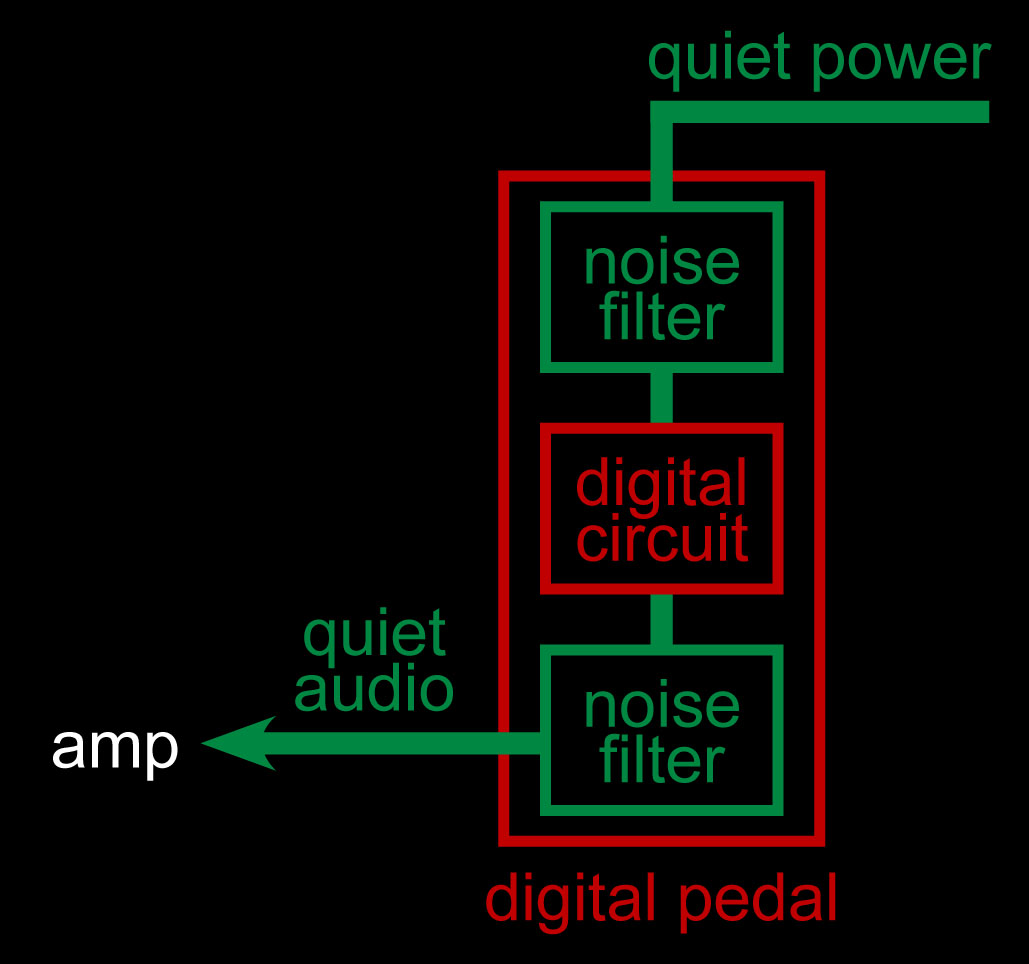 |
|
But some don't keep things around them quiet. They let their "clock noise" escape into their power lines. So if connectoed to a power chain, a special kind of "whine" noise can find its way into the audio lines of other pedals on the chain.
.
Contrary to popular belief, this is NOT a ground loop issue, but a noise filtering issue within the offending pedal.
So, like a problem child, these noisy digital pedals must be isolated from the other children. The problem pedal must be powered by itself on its own isolated power transformer. |
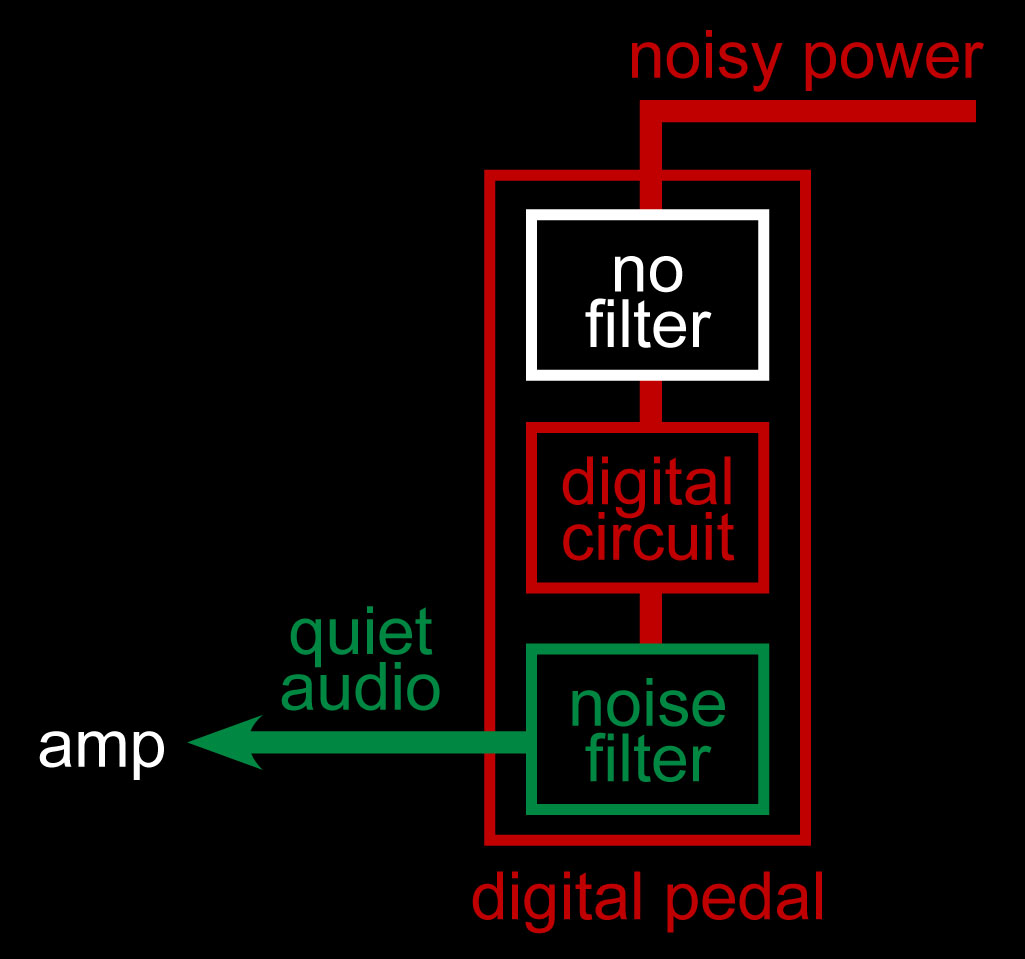 |
|
For a complete discussion of this, see the article Dealing with Digital Noise (Whine) in our Guitar Noise Manual. |
|
NOTEWith PedalSnake, when isolating power, use two separate MF1-H Single P-Line Pigtails, or MF2-I (or MM2-I) Dual Isolated P-Lines on the white 5wire channel. Any 2 isolated power supplies, or power isolated outputs, will work.
When isolation is not required, MF2 Dual P-Line can power pedals of different voltages, like an 18V pedal mixed in with 9V pedals. Use only isolated DC power supplies with MF2. |
|
Isolating Power ChainsSlightly different grounds can exist in devices, even if they are plugged into the same outlet. This is worse when one or more of the devices draws a lot of AC current from the wall, like a tube guitar amp.
Tube amps draw a lot of current, and their power transformer can induce small voltages into the grounded metal chassis. When different ground voltages are connected together, either through audio lines or pedal power chains, and audible hum can result. Stereo amps are often the worst offenders. NOTE As with the example below that uses two amps, isolating with two power supplies can help with FX Loops too. This is needed more often in higher powered all-tube amps. Using two separate isolated power supplies—one for the chain of pedals going to the amp input, and another for the FX Loop pedals, can keep grounds currents out of the audio lines and reduce hum. |
|
|
Because they are the most common offender, we will use two stereo amps here as our example. In the first case, a pedal power chain is the culprit that ties the grounds together.
If the grounds of two stereo amps are tied together by a power chain, and the induced ground voltages are slightly different, 60Hz ground loop current will flow in the grounds of the audio guitar cords. Hum is the result. |
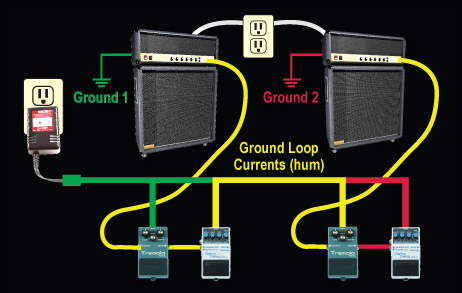 |
|
We are often told the only way to fix this is do away with the power chain. We must rush out and buy an expensive power supply with multiple isolated outputs. Yes, that will fix it, but it is also expensive.
Cost: $150+ All that is needed is to isolate the two power chains on their own separate isolated power supply. Cost: $20 |
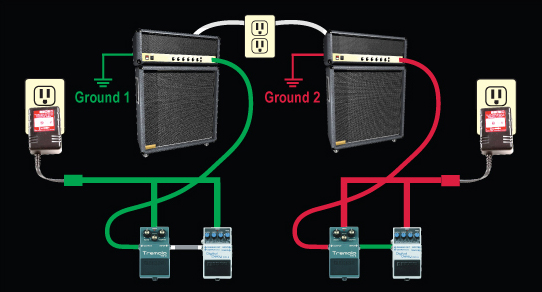 |
|
NOTE In fact, due to the currents induced into the chassis by the transformers, voltages can even be slightly different at different points on the same metal amp chassis! So it can sometimes help to reduce hum by isolating power chains going to the same amp. Use one isolated power transformer for the amp-input chain, and another for the FX Loop chain. |
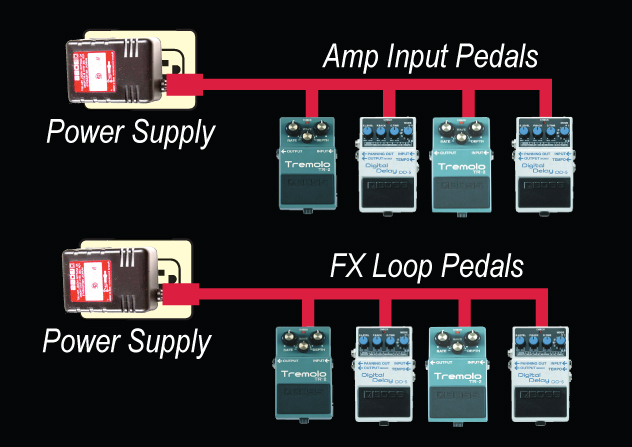 |
|
With PedalSnake, when isolating power, use two separate MF1-H Single P-Line Pigtails, or MF2-I (or MM2-I) Dual Isolated P-Lines on the white 5wire channel. Any 2 isolated power supplies, or power isolated outputs, will work. When isolation is not required, MF2 Dual P-Line can power pedals of different voltages, like an 18V pedal mixed in with 9V pedals. Use only isolated DC power supplies with MF2. |
|
Isolating Two AmpsThe analysis here is the same as for Power Chains (above). Slighly different grounds can exist in devices, even if they are plugged into the same AC power outlet.
This is worse when one or more of the devices draws a lot of current from the wall. Tube amps draw a lot of current. This current flows in the windings of their power transformer, which can induce small voltages into the grounded metal chassis. |
|
|
If the grounds of two amps are tied together by a stereo pedal, and the ground voltages are slightly different, 60Hz ground loop current can flow between the amps in the ground wire of the audio guitar cords. Hum again is the result. Unless one output of a stereo pedal is isolated with a signal transformer, the grounds are being tied together by the two guitar cords going to each amp's input. So ground currents flow in the audio signal ground, causing hum. |
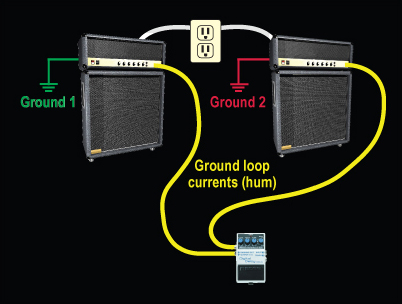 |
|
The only way to break this audio ground loop is too insert an audio isolation transformer on one of the lines. Audio isolation transformers can be found online. Ebtech, Morley, and Rolls make some good ones. Once one audio line is isolated, the grounds are separate, and no more ground currents or hum. |
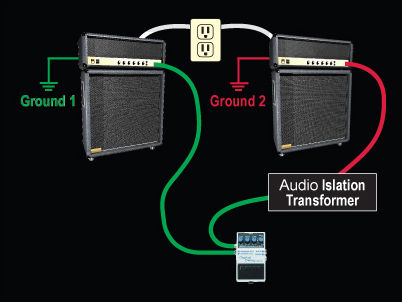 |
|
When isolating audio with PedalSnake, you must keep the grounds of the cables separate. So if the audio transformer is on the pedalboard, use two separate RS1 Single G-Line Pigtails to go from the board to the two amps. Do NOT use an RS2 Dual G-Line, because the 2 lines share the same ground wire.
|
|
PedalSnake® is the trademark for Stage Magic Inc’s All-In-One Stompbox Cable. Copyright © 2015 Stage Magic, Inc.

